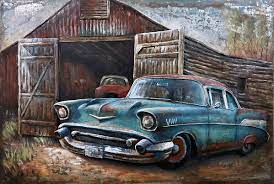
Painting is one of humanity’s oldest and most cherished art forms. It encompasses a wide range of techniques, styles, and traditions, each contributing to the rich tapestry of human creativity. From the ancient cave schilderij of Lascaux to the cutting-edge digital canvases of today, painting has evolved dramatically while remaining a vital means of expression.
The Evolution of Painting
1. Ancient Beginnings:
The earliest known paintings date back to prehistoric times. The Lascaux cave paintings in France, estimated to be around 17,000 years old, depict a variety of animals and hunting scenes. These early works were created using natural pigments and simple tools, providing insight into the lives and beliefs of early humans.
2. Classical and Medieval Periods:
In ancient civilizations such as Egypt, Greece, and Rome, painting became more sophisticated. The Egyptians developed intricate fresco techniques, while Greek artists explored naturalism and perspective. During the medieval period, illuminated manuscripts and religious frescoes dominated, reflecting the spiritual and cultural values of the time.
3. The Renaissance:
The Renaissance, spanning the 14th to the 17th centuries, marked a profound transformation in painting. Artists like Leonardo da Vinci, Michelangelo, and Raphael embraced techniques such as linear perspective and chiaroscuro (the use of strong contrasts between light and dark). This period emphasized realism, humanism, and the revival of classical themes.
4. Modern and Contemporary Art:
The 19th and 20th centuries witnessed radical shifts in artistic approaches. The Impressionists, including Claude Monet and Edgar Degas, challenged traditional notions by focusing on light and color rather than precise details. Later movements such as Cubism, Abstract Expressionism, and Pop Art further pushed the boundaries of painting. Artists like Pablo Picasso, Jackson Pollock, and Andy Warhol experimented with new forms and media.
Techniques and Mediums
Painting techniques and mediums have evolved alongside artistic trends, each contributing unique qualities to the finished work.
1. Traditional Mediums:
- Oil Paint: Known for its rich texture and versatility, oil paint allows for detailed and layered work. It was popularized during the Renaissance and remains a staple in fine art.
- Watercolor: Characterized by its transparency and fluidity, watercolor paint is often used for its delicate and spontaneous effects.
- Acrylic Paint: A more modern medium, acrylic paint dries quickly and can be used on various surfaces. It offers vibrant colors and durability.
2. Modern Innovations:
- Digital Painting: With the advent of technology, digital painting has become increasingly popular. Artists use software and tablets to create artworks that can mimic traditional styles or explore new possibilities.
- Mixed Media: Combining various materials and techniques, mixed media allows artists to experiment with texture and form, creating unique and multidimensional pieces.
The Impact of Painting
Painting serves as a powerful means of communication and reflection. It can capture historical moments, express personal emotions, or challenge societal norms. From the grand historical narratives of classical art to the provocative imagery of contemporary works, painting continues to inspire and provoke thought.
1. Cultural Significance:
Artworks often reflect the cultural and social contexts in which they are created. They provide insight into the values, struggles, and aspirations of different societies and eras.
2. Personal Expression:
For many artists, painting is a deeply personal endeavor. It offers a way to explore and convey their inner world, experiences, and perspectives.
3. Therapeutic Value:
Painting is also recognized for its therapeutic benefits. Engaging in creative processes can promote relaxation, self-discovery, and emotional well-being.
Conclusion
Painting is more than just a medium of artistic expression; it is a testament to human creativity and ingenuity. Whether through the meticulous strokes of a Renaissance masterpiece or the vibrant splashes of a contemporary abstract, painting continues to captivate and inspire. As it evolves and adapts to new technologies and perspectives, painting remains a timeless and universal language of the human experience.